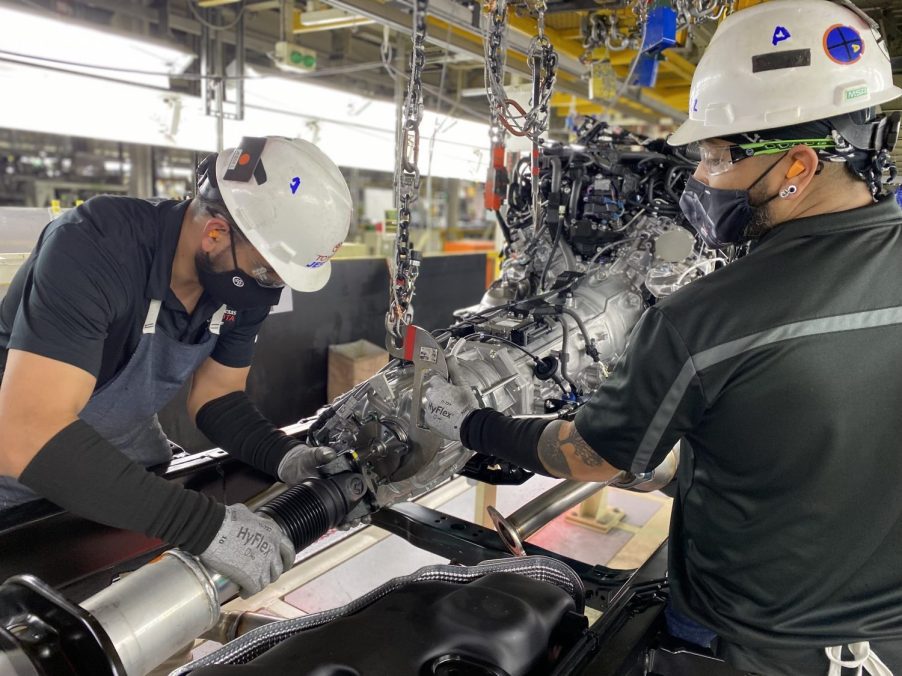
The Toyota Tundra’s i-FORCE V6 Vs Ram’s New Hurricane I6: Battle of the V8 Replacements
Toyota shocked the world when it rolled out its redesigned 2022 Tundra: the automaker chose to toss its naturally-aspirated V8 in favor of a twin-turbocharged V6 similar in displacement and output to the Ford F-150’s EcoBoost. Then in March 2022, Ram unveiled its “V8 replacement,” a twin-turbocharged inline six-cylinder. Here’s how these next-generation truck engines stack up.
| i-FORCE V6 | “Hurricane” I6 | i-FORCE MAX hybrid | HO “Hurricane” I6 | |
| Displacement | 3.44 liters | 3.0 liters | 3.44 liters | 3.0 liters |
| Horsepower | 389 horsepower | 400+ horsepower | 437 horsepower | 500+ horsepower |
| Torque | 479 lb-ft | 450+ lb-ft | 583 lb-ft | 475+ lb-ft |
| Boost | 18 psi | 22 psi | 18 psi | 26 psi |
| Electric Motor | N/A | N/A | 48 hp/184 lb-ft | N/A |
What is an i-FORCE Max engine?
The premium version of the 2022 Toyota Tundra’s twin-turbocharged V6 is the i-FORCE MAX hybrid version. With a 184 lb-ft electric motor sandwiched between the 3.44-liter V6 and 10-speed automatic, it makes more torque than the Ford F-150 Raptor.

The new Toyota Tundra’s V6 actually comes in three separate tunes, based on trim level. But every Tundra will have the same engine. The Tundra SR’s 3.44-liter V6 only makes 348 horsepower and 405 lb-ft of torque. Every other non-hybrid trim level makes 389 horsepower/479 lb-ft of torque.
If you buy a 2022 Toyota Tundra TRD Pro, a Tundra Capstone, or choose to upgrade the engine in a mid-trim truck, you get the i-FORCE MAX hybrid powertrain. MotorTrend was very impressed with the hybrid’s “diesel-like” flat torque curve. Toyota accomplished this by carefully tuning the i-FORCE MAX to smoothly transition from an all-electric launch to electric/V6 acceleration, to turbocharged V6 cruising.
What is a Hurricane engine?
Stellantis’ new Hurricane engine is a turbocharged inline six-cylinder aiming to make the HEMI V8 obsolete. It’s only 3.0-liters, but with 26 psi of boost, the high output variant will make 500+ horsepower.

Inline six-cylinder engines (also called “straight sixes”) were once hugely popular. From the 1920s through the 1980s, straight sixes dominated the Chrysler Corporation’s lineup. The Flathead Six, then the later Slant Six were the base engines for most midcentury Chrysler products.
But straight six engines are a bit long for some engine bays, can be heavy, and can be expensive to build. V8s became the most popular engine for trucks. But now reliable turbocharging promises to boost straight-six engines to V8 power levels.
Stellantis claims its new turbocharger 3.0-liter I6’s standard output variant will surpass the 5.7-liter HEMI V8 with 400+ horsepower and 450+ lb-ft of torque. It also claims the high output variant will beat the 6.4-liters (392 cubic inches) HEMI V8 with its 500 + horsepower and 475+ lb-ft of torque. Its unsurprising that the automaker says its “twin-turbo I-6 is the primary internal combustion power plant of the future in North America for vehicles using the STLA Large and STLA Frame platforms.”
The Ram 1500 vs the Toyota Tundra

The Toyota Tundra dropped its V8 for the 2022 model year, and the Ram 1500 may not be far behind. Though both trucks are going to six-cylinder engines, the two automakers have opposite approaches.
The Tundra’s powerplant is a turbocharged V6 with a hybrid option, similar in specs and output to Ford’s PowerBoost. The new Ram engine is a straight-six with twin turbochargers.
There are no long-term test results from either new truck engine. That said, even the high-output tune of the Hurricane should be easier and cheaper to work on than the hybrid i-FORCE MAX. On the other hand, with a slightly more powerful electric motor and a larger battery pack, the next generation of the i-FORCE MAX could be a gas-saving plug-in hybrid.
See the 2022 Toyota Tundra and 2022 (V8) Ram 1500 go head-to-head in the video below:



